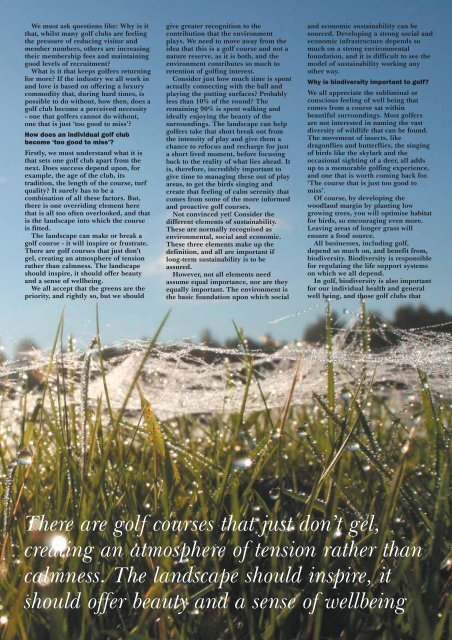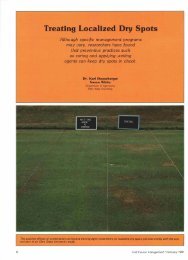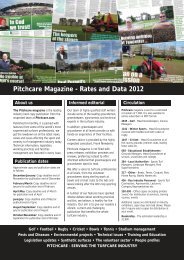Marshalling his troops - Pitchcare
Marshalling his troops - Pitchcare
Marshalling his troops - Pitchcare
Create successful ePaper yourself
Turn your PDF publications into a flip-book with our unique Google optimized e-Paper software.
We must ask questions like: Why is it<br />
that, whilst many golf clubs are feeling<br />
the pressure of reducing visitor and<br />
member numbers, others are increasing<br />
their membership fees and maintaining<br />
good levels of recruitment?<br />
What is it that keeps golfers returning<br />
for more? If the industry we all work in<br />
and love is based on offering a luxury<br />
commodity that, during hard times, is<br />
possible to do without, how then, does a<br />
golf club become a perceived necessity<br />
- one that golfers cannot do without,<br />
one that is just ‘too good to miss’?<br />
How does an individual golf club<br />
become ‘too good to miss’?<br />
Firstly, we must understand what it is<br />
that sets one golf club apart from the<br />
next. Does success depend upon, for<br />
example, the age of the club, its<br />
tradition, the length of the course, turf<br />
quality? It surely has to be a<br />
combination of all these factors. But,<br />
there is one overriding element here<br />
that is all too often overlooked, and that<br />
is the landscape into which the course<br />
is fitted.<br />
The landscape can make or break a<br />
golf course - it will inspire or frustrate.<br />
There are golf courses that just don’t<br />
gel, creating an atmosphere of tension<br />
rather than calmness. The landscape<br />
should inspire, it should offer beauty<br />
and a sense of wellbeing.<br />
We all accept that the greens are the<br />
priority, and rightly so, but we should<br />
give greater recognition to the<br />
contribution that the environment<br />
plays. We need to move away from the<br />
idea that t<strong>his</strong> is a golf course and not a<br />
nature reserve, as it is both, and the<br />
environment contributes so much to<br />
retention of golfing interest.<br />
Consider just how much time is spent<br />
actually connecting with the ball and<br />
playing the putting surfaces? Probably<br />
less than 10% of the round? The<br />
remaining 90% is spent walking and<br />
ideally enjoying the beauty of the<br />
surroundings. The landscape can help<br />
golfers take that short break out from<br />
the intensity of play and give them a<br />
chance to refocus and recharge for just<br />
a short lived moment, before focusing<br />
back to the reality of what lies ahead. It<br />
is, therefore, incredibly important to<br />
give time to managing these out of play<br />
areas, to get the birds singing and<br />
create that feeling of calm serenity that<br />
comes from some of the more informed<br />
and proactive golf courses.<br />
Not convinced yet! Consider the<br />
different elements of sustainability.<br />
These are normally recognised as<br />
environmental, social and economic.<br />
These three elements make up the<br />
definition, and all are important if<br />
long-term sustainability is to be<br />
assured.<br />
However, not all elements need<br />
assume equal importance, nor are they<br />
equally important. The environment is<br />
the basic foundation upon which social<br />
and economic sustainability can be<br />
sourced. Developing a strong social and<br />
economic infrastructure depends so<br />
much on a strong environmental<br />
foundation, and it is difficult to see the<br />
model of sustainability working any<br />
other way.<br />
Why is biodiversity important to golf?<br />
We all appreciate the subliminal or<br />
conscious feeling of well being that<br />
comes from a course sat within<br />
beautiful surroundings. Most golfers<br />
are not interested in naming the vast<br />
diversity of wildlife that can be found.<br />
The movement of insects, like<br />
dragonflies and butterflies, the singing<br />
of birds like the skylark and the<br />
occasional sighting of a deer, all adds<br />
up to a memorable golfing experience,<br />
and one that is worth coming back for.<br />
‘The course that is just too good to<br />
miss’.<br />
Of course, by developing the<br />
woodland margin by planting low<br />
growing trees, you will optimise habitat<br />
for birds, so encouraging even more.<br />
Leaving areas of longer grass will<br />
ensure a food source.<br />
All businesses, including golf,<br />
depend so much on, and benefit from,<br />
biodiversity. Biodiversity is responsible<br />
for regulating the life support systems<br />
on which we all depend.<br />
In golf, biodiversity is also important<br />
for our individual health and general<br />
well being, and those golf clubs that<br />
There are golf courses that just don’t gel,<br />
creating an atmosphere of tension rather than<br />
calmness. The landscape should inspire, it<br />
should offer beauty and a sense of wellbeing

















